美英报刊阅读教程Lesson 1 课文
英美报刊选读Unit1.2.9
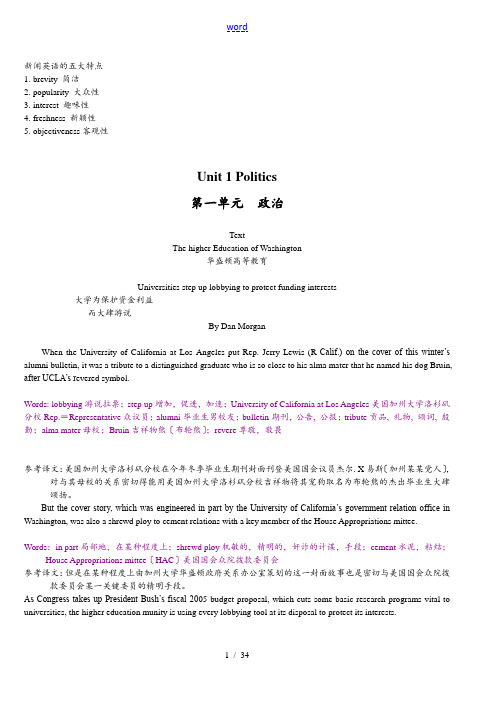
新闻英语的五大特点1. brevity 简洁2. popularity 大众性3. interest 趣味性4. freshness 新颖性5. objectiveness客观性Unit 1 Politics第一单元政治TextThe higher Education of Washington华盛顿高等教育Universities step up lobbying to protect funding interests大学为保护资金利益而大肆游说By Dan MorganWhen the University of California at Los Angeles put Rep. Jerry Lewis (R-Calif.) on the cover of this winter’s alumni bulletin, it was a tribute to a distinguished graduate who is so close to his alma mater that he named his dog Bruin, after UCLA’s r evered symbol.Words: lobbying游说拉票;step up增加,促进,加速;University of California at Los Angeles美国加州大学洛杉矶分校Rep.=Representative众议员;alumni毕业生男校友;bulletin期刊,公告, 公报;tribute贡品, 礼物, 颂词, 殷勤;alma mater母校;Bruin吉祥物熊〔布轮熊〕;revere尊敬,敬畏参考译文:美国加州大学洛杉矶分校在今年冬季毕业生期刊封面刊登美国国会议员杰尔. X易斯〔加州某某党人〕,对与其母校的关系密切得能用美国加州大学洛杉矶分校吉祥物将其宠狗取名为布轮熊的杰出毕业生大肆颂扬。
But the cover story, which was engineered in part by the University of California’s government relation office in Washington, was also a shrewd ploy to cement relations with a key member of the House Appropriations mittee.Words:in part局部地,在某种程度上;shrewd ploy机敏的,精明的,奸诈的计谋,手段;cement水泥,粘结;House Appropriations mittee〔HAC〕美国国会众院拨款委员会参考译文:但是在某种程度上由加州大学华盛顿政府关系办公室策划的这一封面故事也是密切与美国国会众院拨款委员会某一关键委员的精明手段。
经贸专业英语报刊阅读教程 第一课 Good policy, and bad

Good policy, and badSome mitigation policies are effective,some are efficient, and some are neitherDec 3rd 2009 | from the print editionGREENHOUSE-GAS emissions targets can be implemented through three sorts ofpolicy instruments—regulation, carbon-pricing and subsidies. Governmentsgenerally like regulation (because it appears to be cost-free), economists likecarbon prices (because they are efficient) and businesses like subsidies (becausethey get the handouts).Regulation can be useful where the market is not working well. Buildings are rarelydesigned to save energy, because those who put them up do not usually pay thebills and those who occupy them choose them for their views or their looks, not theirenergy-efficiency. The same goes for appliances, most of which do not use enoughenergy to affect consumers' choices. Small regulatory changes (see box, next page)can cut energy consumption without distorting the market much. According toMcKinsey, around one-third of the required greenhouse-gas reductions will actuallysave money.In this special reportGetting warmerIs it worth it?The green slump»Good policy, and badVampires on a dietCap and tiradeWho cares?A long gameClosing the gapsWhat needs to changeUnpacking the problemSources & acknowledgementsReprintsRelated topics ChinaSolar energyEuropean UnionAlternative energyEuropeThe European Union's Emissions-Trading Scheme, which started up in 2005, is theonly large-scale attempt so far to set a carbon price. Under the ETS, EU countriesget national allocations which they then parcel out to over 11,500 factories in fivedirty industries. Companies can buy and sell allocations amongst themselves, andcan also buy “certified emission reductions” from developing countries to meet theircaps through Kyoto's “clean development mechanism”.Europe's flagshipThe ETS makes up the vast bulk of the global carbon market, which will be wortharound $122 billion this year. It is the principal way of financing the shift from high-to low-carbon power and industrial processes in the developing world. A wind farmin India; a methane-capture scheme for pig farms in Brazil; a forestry project inIndonesia; equipment to capture industrial gases in China—the ETS can financethem all.Although it is still young, the ETS has had some impact on emissions. According toa 2008 study at the Massachusetts Institute of Technology, in its first three years itprobably reduced them by 120m-300m tonnes, or 2-5% a year, below what theywould otherwise have been.2000.This sort of energy is expensive. The best indication of that is the carbon price thatwould be required to make investment in renewables worthwhile without subsidy.According to New Energy Finance, onshore wind energy needs a carbon price of $38,offshore of $136 and solar cells of $196. Europe's target for generating 20% of itsenergy from renewable sources therefore looks pricey. According to Richard Green,director of the Institute for Energy Research and Policy at Birmingham University,the implied marginal cost of carbon would be €129 a tonne—which suggests thatallocating such large resources to renewable-energy subsidies is, as Mr Green says,“seriously sub-optimal”.The worst example of a wasteful subsidy is America's support programme forhome-grown corn ethanol, which is coupled with tariffs on cheaper sugar-caneethanol from Brazil. The programme has raised global food prices (and thusincreased malnutrition among the world's poorest); lined the pockets of America'sfarmers; given policies to cut carbon a bad name; and cut little, if any, carbon.Solar flareThe resulting boom benefited manufacturers not just in Spain but also in Germanyand China, the biggest producers of solar cells. Last year Spain accounted for 40%of world demand. The government had planned for 400MW of solar capacity to bebuilt by2008. “There were all sorts of abuses,” says Jenny Cha se, solaranalyst at New Energy Finance. “If you connected a single module to the grid beforeSeptember 29th, your whole project got financed. So modules were changing handsfor vast sums of money.” After the deadline the market collapsed.Mr Clover is con cerned about the likely effect. “We're expecting a stampede inGlobally, New Energy Finance reckons that only $24 billion of green-stimulus moneywill be disbursed this year, with another $58 billion to follow in 2010 and a further$56 billion in。
英语报刊阅读教程unit 1 Culture, Education and Religion

D. Freshmen can have chance to experience tougher academic requirements of higher education before the start tWhat is the Problem of graduate rate and retention rate in UNR?
Last year, slightly more than half of the freshmen who entered UNR in 2006 graduated.
一项新的倡议提出,一旦有大量的女孩退学, 当地的领导就应该被免职。
Vocabulary
3. credit…to:为…增光的人[事物],记入……帐 目。
但是很难将太多功劳归功于该目标本身。 But it is hard to assign much credit to the exercise
exams. D
2. What is the purpose of UNR’s boot camp?
A. To improve the chance of surviving their first semester of university. B. To improve the graduation rate. C. To improve the retention rate. D. All of the above.
取消(原有安排)
Regularly scrub them to make sure germs aren't germinating.
经常擦洗垃圾桶,确保细菌不会滋生 。
最新美英报刊阅读lesson1精品课件

《华盛顿邮报》
关注美国政治局势,分析 选举、立法等政治事件。
经济类文章选读
《华尔街日报》
剖析全球经济趋势,报道金融市场动 态及企业盈利情况。
《经济学人》
以全球视角关注经济现象,提供深度 分析和评论。
《金融时报》
分析国际贸易、投资等经济问题,探 讨各国经济发展战略。
社会文化类文章选读
《纽约客》
探讨美国社会文化现象,包括艺 术、文学、电影等领域。
位于文章开头,简要介绍新闻事件的重要性 和核心内容。
正文(Body)
结尾(Conclusion)
详细阐述新闻事件的经过、相关背景、涉及 人物等。
总结文章内容,可能包含评论、预测或后续 行动建议。
语言特点与表达
使用专业术语
美英报刊文章涉及各个领域,会使用相应 领域的专业术语。
准确具体
新闻写作要求准确具体,避免模糊和歧义 的表达。
《卫报》
关注英国社会动态,报道文化、教 育、科技等方面的新闻问题。
05
阅读理解与练习
阅读理解技巧
主题句识别
快速定位段落主题句,把握文章 大意。
细节理解
关注文章中的关键信息,理解作 者观点和态度。
推理判断
根据文章内容进行推理,判断作 者意图和言外之意。
最新美英报刊阅读lesson1精品 课件
CONTENTS
• 课程介绍与背景 • 阅读技巧与策略 • 美英报刊文章特点 • 美英报刊选读 • 阅读理解与练习 • 课程总结与展望
01
课程介绍与背景
美英报刊阅读的目的
提高学生阅读和理解美英报刊杂 志的能力 帮助学生了解国际时事和英美文 化 培养学生的批判性思维和独立思 考能力
英语阅读教程第一课
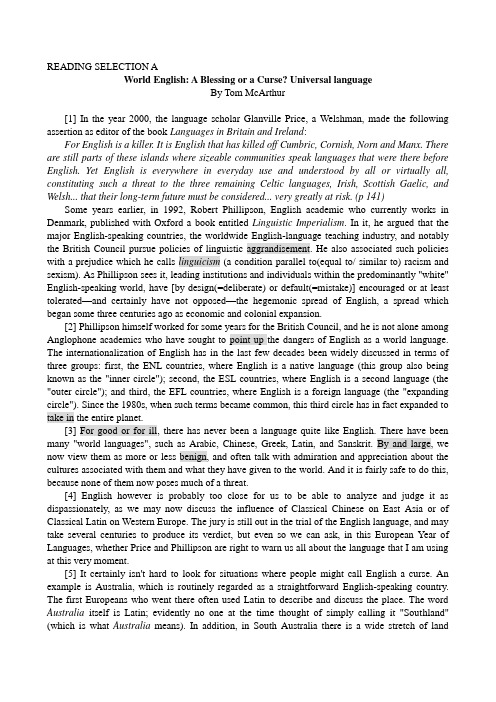
READING SELECTION AWorld English: A Blessing or a Curse? Universal languageBy Tom McArthur[1] In the year 2000, the language scholar Glanville Price, a Welshman, made the following assertion as editor of the book Languages in Britain and Ireland:For English is a killer. It is English that has killed off Cumbric, Cornish, Norn and Manx. There are still parts of these islands where sizeable communities speak languages that were there before English. Yet English is everywhere in everyday use and understood by all or virtually all, constituting such a threat to the three remaining Celtic languages, Irish, Scottish Gaelic, and Welsh... that their long-term future must be considered... very greatly at risk. (p 141) Some years earlier, in 1992, Robert Phillipson, English academic who currently works in Denmark, published with Oxford a book entitled Linguistic Imperialism. In it, he argued that the major English-speaking countries, the worldwide English-language teaching industry, and notably the British Council pursue policies of linguistic aggrandisement. He also associated such policies with a prejudice which he calls linguicism (a condition parallel to(equal to/ similar to) racism and sexism). As Phillipson sees it, leading institutions and individuals within the predominantly "white" English-speaking world, have [by design(=deliberate) or default(=mistake)] encouraged or at least tolerated—and certainly have not opposed—the hegemonic spread of English, a spread which began some three centuries ago as economic and colonial expansion.[2] Phillipson himself worked for some years for the British Council, and he is not alone among Anglophone academics who have sought to point up the dangers of English as a world language. The internationalization of English has in the last few decades been widely discussed in terms of three groups: first, the ENL countries, where English is a native language (this group also being known as the "inner circle"); second, the ESL countries, where English is a second language (the "outer circle"); and third, the EFL countries, where English is a foreign language (the "expanding circle"). Since the 1980s, when such terms became common, this third circle has in fact expanded to take in the entire planet.[3] For good or for ill, there has never been a language quite like English. There have been many "world languages", such as Arabic, Chinese, Greek, Latin, and Sanskrit. By and large, we now view them as more or less benign, and often talk with admiration and appreciation about the cultures associated with them and what they have given to the world. And it is fairly safe to do this, because none of them now poses much of a threat.[4] English however is probably too close for us to be able to analyze and judge it as dispassionately, as we may now discuss the influence of Classical Chinese on East Asia or of Classical Latin on Western Europe. The jury is still out in the trial of the English language, and may take several centuries to produce its verdict, but even so we can ask, in this European Year of Languages, whether Price and Phillipson are right to warn us all about the language that I am using at this very moment.[5] It certainly isn't hard to look for situations where people might call English a curse. An example is Australia, which is routinely regarded as a straightforward English-speaking country. The first Europeans who went there often used Latin to describe and discuss the place. The word Australia itself is Latin; evidently no one at the time thought of simply calling it "Southland" (which is what Australia means). In addition, in South Australia there is a wide stretch of landcalled the Nullarbor Plains, the first word of which sounds Aboriginal, but nullarbor is Latin and means "no trees". And most significantly of all, the early settlers called the continent a terra nullius. According to the Encarta World English Dictionary (1999) the Latin phrase terra nullius means: ... the idea and legal concept that when the first Europeans arrived in Australia the land was owned by no one and therefore open to settlement. It has been judged not to be legally valid.But that judgment was made only recently. When the Europeans arrived, Australia was thinly populated—but populated nonetheless—from coast to coast in every direction. There were hundreds of communities and languages. Many of these languages have died out, many more are in the process of dying out, and these dead and dying languages have been largely replaced by either kinds of pidgin English or general Australian English. Depending on your point of view, this is either a tragic loss or the price of progress.[6] At the same time, however, can the blame for the extinction of Aboriginal languages be laid specifically at the door of English? The first Europeans to discover Australia were Dutch, and their language might have become the language of colonization and settlement. Any settler language could have had the same effect. If for example the Mongols had sustained their vast Eurasian empire, Mongolian might have become a world language and gone to Australia. Again, if history had been somewhat different, today's world language might have been Arabic, a powerful language in West Asia and North Africa that currently affects many smaller languages, including Coptic and Berber. Spanish has adversely affected indigenous languages in so-called "Latin" America, and Russian has spread from Europe to the Siberian Pacific. If English is a curse and a killer, it may only be so in the sense that any large language is likely to influence and endanger smaller languages.[7] Yet many people see English as a blessing. Let me leave aside here the obvious advantages possessed by any world language, such as a large communicative network, a strong literary and media complex, and a powerful cultural and educational apparatus. Let us instead look at something rather different: the issue of politics, justice, and equality. My object lesson this time is South Africa. Ten years ago, South Africa ceased to be governed on principles of racial separateness, a system known in Afrikaans (a language derived from Dutch) as apartheid. The system arose because the Afrikaner community—European settlers of mainly Dutch descent—saw themselves as superior to the indigenous people of the land they had colonized.[8] English-speaking South Africans of British descent were not particularly strong in opposing the apartheid regime, and the black opposition, whose members had many languages, was at first weak and disorganized. However, the language through which this opposition gained strength and organization was English, which became for them the key language of freedom and unity, not of oppression. There are today eleven official languages in South Africa—English, Afrikaans, and nine vernacular languages that include Zulu, Ndebele, and Setswana. But which of these nine do black South Africans use (or plan to use) as their national lingua franca? Which do they wish their children to speak and write successfully (in addition to their mother tongues)? The answer is none of the above. They want English, and in particular they want a suitably Africanized English.[9] So, a curse for the indigenous peoples of Australia and something of a blessing for those in South Africa...[10] How then should we think of English in our globalizing world with its endangered diversities? The answer, it seems to me, is crystal clear. Like many things, English is at times a blessing and at times a curse—for individuals, for communities, for nations, and even for unions ofnations. The East Asian symbolism of yin and yang might serve well here: There is something of yang in every yin, of yin in every yang. Although they are opposites, they belong together: in this instance within the circle of communication. Such symbolism suggests that the users of the world's lingua franca should seek to benefit as fully as possible from the blessing and as far as possible avoid invoking the curse. (1, 292 words)ABOUT THE AUTHORDr. Tom McArthur is founder editor of the Oxford Companion to the English Language (1992) and the quarterly English Today: The International Review of the English Language (Cambridge, 1985—). His more than 20 published works include the Longman Lexicon of Contemporary English (1981), Worlds of Reference: Language, Lexicography and Learning from the Clay Tablet to the Computer (1986), and The English Languages (1998). He is currently Deputy Director of the Dictionary Research Center at the University of Exeter.EXERCISESI. Reading ComprehensionAnswer the following questions or complete the, following statements.1. It can be inferred from Glanville Price's statement that he is ______.A. happy that English is everywhere in Britain and IrelandB. worried about the future of the remaining Celtic languagesC. shocked by the diversity of languages in Britain and IrelandD. amazed that many people in the UK still speak their Aboriginal languages2. Cumbric is used as an example of ______.A. a local dialectB. a victim of the English languageC. a language that is on the verge of extinctionD. a language that is used by only a limited number of people3. Which of the following is the major concern of the book Linguistic Imperialism?A. English teaching overseas.B. British government's language policies.C. Dominance of English over other languages.D. The role of English in technology advancement.4. Both Price and Phillipson are ______.A. government officialsB. advocates of linguistic imperialismC. in support of language policies carried out by the British CouncilD. concerned about the negative effect of English on smaller languages5. According to the text, the EFL countries ______.A. are large in numberB. is known as the "outer circle"C. will be endangered by EnglishD. have made English their official language6. According to McArthur, Chinese is different from English in that ______.A. it has made a great contribution to the worldB. it has had positive influence on other languagesC. it may result in the disappearance of other languagesD. it probably will not endanger the existence of other languages7. When he said the jury is out in the trial" (Line 3, Paragraph 4), McArthur meant ______.A. punishment is dueB. the jury is waiting for a trialC. no decision has been made yetD. there is no one to make the decision8. Australia might be used as an example to show that ______.A. languages are changing all the timeB. some English words are derived from LatinC. English has promoted the progress of some nationsD. English should be blamed for the extinction of smaller languages9. Many people see English as a blessing for people in ______.A. AustraliaB. East AsiaC. South AfricaD. ESL countries10. The main theme of this speech is that ______.A. English should be taught worldwideB. English as a world language does more harm than goodC. we should be objective to the internationalization of EnglishD. we should be aware of (realize) the danger of English as a world languageB. Questions on global understanding and logical structures1. Why does McArthur introduce Glanville Price and Robert Phillipson's points of view on the spread of English? What is his? Intention?McArthur quotes Price’s assertion and cites Pillipson’s viewpoint on the spread of English as sort of cons to initiate his argument. Cons are usually popularly believed arguments or opinions that are against the author’s point of view. Cons are commonly used writing techniques and are often employed in order to appeal the audience and highlight the author’sviewpoint.2. Does McArthur agree with what Price and Phillipson argued? From as early as which section does McArthur show his attitude? Toward the dominance of English as a world English?No. McArthur’s opinion is different from Price and Pillipson’s arguments. He doesn’t believe that English is a killer and should be blamed for the extinction of smaller languages. He seesEnglish as both a blessing and a curse, maybe as a blessing more than a curse. After introducing Price and Pillipson’s viewpoints, McArthur writes about his own ideas on the issue of En glish as a world language. From the sentence “For good or for ill, there has never been a language quite like English”, we can learn that McArthur does not curse English like Price and Pillipson and he has a different point of view.3. By reading "It certainly isn't hard to look for situations where people might call English a curse", could we conclude that McArthur believes English is a curse?No. This sentence is a kind of justification. Although McArthur literally justifies the fact that there are situ ations where people might call English a curse, he doesn’t believe that English is virtually a curse. By adding the word “certainly” McArthur shows his intent.4. Could you pick up some words and expressions that signal change or continuation in McArthur's thought?“For good or for ill”(paragraph 3) /“however”(paragraph 4) /“But”(paragraph 5) / “At the same time, however”(paragraph 6) /“Yet”(paragraph 7)5. How many parts can this speech be divided? How are the parts organized?Part One: paragraphs 1 and 2. These two paragraphs introduce the situation that many academics argue against English as a world language.Part Two: paragraphs 3, 4, 5, 6, 7, 8, and 9. Paragraph three is a transitional paragraph that initiates McArthur’s own argument. In these pa ragraphs McArthur argues that English is not only a curse as many people have believed, but a blessing as well.Part Three: paragraph 10. McArthur concludes in the last paragraph that English may be a curse or a blessing depends on different situations and we should make advantages of world languages and avoid their disadvantages.II. VocabularyA. Choose the best word from the four choices to complete each of the following sentences.1. There has been much opposition from some social groups, ______ from the farming community.A. straightforwardlyB. notablyC. virtuallyD. exceptionally2. The ______ view in Britain and other Western countries associates aging with decline, dependency, isolation, and often poverty.A. predominantB. credulousC. inclusiveD. sustainable3. But gifts such as these cannot be awarded to everybody, either by judges or by the most ___ of governments./ reward rewardingA. toughB. demandingC. diverseD. benign4. The foreman read the ______ of guilty fourteen times, one for each defendant.A. prejudiceB. verificationC. verdictD. punishment5. They fear it could have a(n) ______ effect on global financial markets.A. sizeableB. adverse(negative)C. beneficialD. consequential6. The UN threatened to ______ economic sanctions if the talks were broken off.A. engageB. pursueC. abandon/ abundantD. invoke7. There are at least four crucial differences between the new ______ and the old government.A. regimeB. hegemonyC. complexD. federation/ fedal<->federal, confederate)8. These questions ______ a challenge to established attitude of superiority toward the outside world.A. evolveB. constituteC. tolerateD. aroused9. Because of this, a strong administrative ______ was needed to plan the use of scarce resources, organize production and regulate distribution.A. apparatusB. constitutionC. insistenceD. promotion10. I learnt that there are no genuinely ______ animals in this area, all the animals were brought here from other places.A. endangeredB. domesticatedC. indigenousD. extinctB. Choose the hest word or expression from the list given for each Honk Use each word or expression only once and make proper changes where necessary.point up by and large take in descent for good or illleave aside crystal clear die out endanger lay... at the door of1. The book concludes with a review of the possible impact (influence) of more intimate computers for good or ill, in various areas of human life.2. Moreover, it had become clear from the opinion polls that the unpopularity of the new tax was being laid at the door of the government which had introduced it, rather than the local authorities who were responsible for levying and collecting it.3. This case gave the example of breaking someone's arm: that is a really serious injury, but one which is unlikely to endanger the victim's life.4. Many of those who hold it live in poor areas and some are Colored, that is (i.e./ namely), of mixed European and African descent.5. This debate is important because it points up (stress/ emphasize) that "the facts" are not necessarily as simple and straightforward as they might at first sight seem.6. In the beginning, the meaning of life might be debated, but once past the first period, many of the conversations follow a well-worn route from one topic to the next and back again, taking in most of human life.7. But since agriculture forms the basis (base) of our industry, it was, by and large (on the whole), also an intensification of the crisis in the national economy in general.8. Let us leave aside other relevant factors such as education, career structure, pay and conditions of service and concentrate on (focus on) manpower management.(relate A to B)9. It is true that the exact nature of this issue is uncertain. However, one thing is crystal clear: it will not endanger the planet and its inhabitants.10. But if animal populations are too small, then they simply die out.III. ClozeThere are ten blanks in the following passage. Read the passage carefully and choose the best answer from the four choices given for each blank. [criteria: (1)semantic/ (2)grammatic]A simplified form of the English language based on 850 key words was developed in the late 1920s by the English psychologist Charles Kay Ogden and 1 by the English educator I. A. Richards. Known as Basic English, it was used mainly to teach English to non-English-speaking persons and 2 as an international language. The complexities of English spelling and grammar, however, were major 3 to the adoption of Basic English as a second language.The fundamental principle of Basic English was that any idea, 4 complex, may be reduced to simple units of thought and expressed clearly by a limited number of everyday words. The 850-word primary vocabulary was 5 600 nouns (representing things or events), 150 adjectives (for qualities and _ 6 ), and 100 general "operational" words, mainly verbs and prepositions. Almost all the words were in 7 use in English-speaking countries. More than 60 percent of them were one-syllable words. The basic vocabulary was created 8 by eliminating 9 the use of 18 "basic" verbs, such as make, get, do, have, and be.Numerous words which have the same or similar meanings and by verbs, such as make, get, do, have, and be. These verbs were generally combined with prepositions, such as up, among, under, in, and forward. For example, a Basic English student would use the expression “go up”10 "ascend". (Semantic / grammatical criterion)1. A. created B. publicized C. invented D. operated2. A. proved B. provided C. projected D. promoted3. A. advantages B. objections C. obstacles D. facileties4. A. however B. whatever C. wherever D. whenever5. A. comprised of B. made of C. composed of D. constituted of6. A. personalities B. properties C. preferences D. perceptions/ perceive)7. A. common B. ordinary C. average D. nonprofessional8. A. in all B. at times C. for good D. in part/ partially)9. A. experiencing B. exchanging C. excluding D. extending10. A. in spite of =despite B. in favor of C. instead of D. in case ofII. TranslationPut the following passages into Chinese.1. For English is a killer. It is English that has killed off Cumbric, Cornish, Norn and Manx. There are still parts of these islands where sizeable communities speak languages that were there before English. Yet English is everywhere in everyday use and understood by all or virtually all, constituting such a threat to the three remaining Celtic languages, Irish, Scottish Gaelic, and Welsh... that their long-term future must be considered... very greatly at risk.因为英语是个杀手。
(完整版)lesson1-研究生英语阅读教程(提高级_第三版)原文及翻译
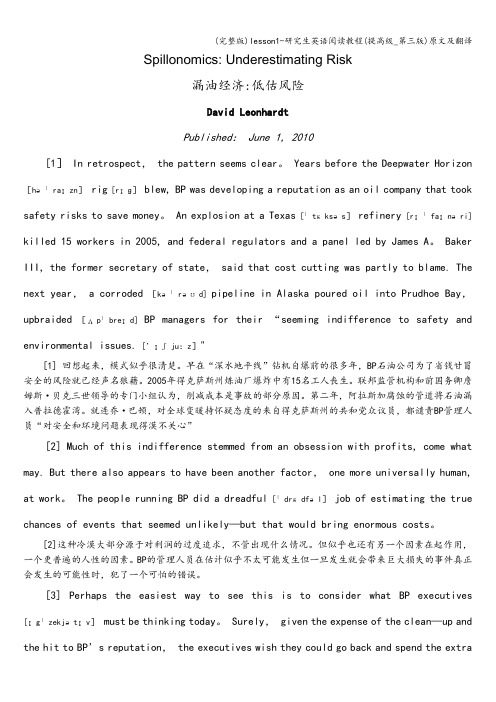
Spillonomics: Underestimating Risk漏油经济:低估风险David LeonhardtPublished: June 1, 2010[1] In retrospect, the pattern seems clear。
Years before the Deepwater Horizon [həˈraɪzn] rig[rɪɡ]blew, BP was developing a reputation as an oil company that took safety risks to save money。
An explosion at a Texas [ˈtɛksəs]refinery [rɪˈfaɪnəri] killed 15 workers in 2005, and federal regulators and a panel led by James A。
Baker III, the former secretary of state, said that cost cutting was partly to blame. The next year, a corroded [kəˈrəʊd] pipeline in Alaska poured oil into Prudhoe Bay,upbraided[ʌpˈbreɪd] BP managers for their “seeming indifference to safety and environmental issues. [’ɪʃju:z]"[1] 回想起来,模式似乎很清楚。
早在“深水地平线”钻机自爆前的很多年,BP石油公司为了省钱甘冒安全的风险就已经声名狼藉。
2005年得克萨斯州炼油厂爆炸中有15名工人丧生。
联邦监管机构和前国务卿詹姆斯·贝克三世领导的专门小组认为,削减成本是事故的部分原因。
《美英报刊阅读教程》

《美英报刊阅读教程》
端木义万
Free Powerpoint Templates
Page 1
Lesson 6
D.C. Influentials
By David T. Cook and Gail Russell Chaddock
Key to Questions
Photos & Diagrams
Additional Notes
Background Information
The lobbying exists in many countries, but the most developed is in America. Washington can be regarded as the street of lobby.
change their positions in this process.
Background Information
The existence of lobbying in America has the following four reasons.
2024版美英报刊阅读ppt课件[1]
![2024版美英报刊阅读ppt课件[1]](https://img.taocdn.com/s3/m/25b823cc82d049649b6648d7c1c708a1284a0aa2.png)
影响力
美英报刊作为重要的信息传播媒介,对于 社会舆论的形成和引导具有重要作用。它 们通过报道新闻事件、发表评论和分析等 方式,影响读者的思想和行为。
VS
传播方式
美英报刊的传播方式主要包括印刷传播、 电子传播和网络传播等。其中,印刷传播 是最传统的传播方式,通过纸质报纸和杂 志进行传播;电子传播则通过电视、广播 等电子媒介进行传播;网络传播则是近年 来兴起的传播方式,通过互联网进行传播, 具有速度快、范围广、互动性强等特点。
8
阅读中的理解与分析
01
02
03
04
把握文章大意
快速浏览全文,了解文章的主 题、结构和主要观点。
2024/1/28
深入阅读
仔细阅读文章,理解作者的观 点、论据和论证过程,注意文
章中的重点、难点和疑点。
分析文章特点
关注文章的写作风格、语言运 用和修辞手法,体会作者的表
达方式和思想内涵。
批判性思维
对文章中的观点和信息进行独 立思考和判断,不盲目接受作
2024/1/28
22
评论与专栏中的观点与立场
2024/1/28
政治立场
01
反映作者或报刊的政治倾向。
文化立场
02
体现对社会、文化现象的态度和看法。
经济立场
03
分析经济现象,预测趋势,提出政策建议。
23
05 美英报刊中的广 告与文化
2024/1/28
24
广告的种类与特点
2024/1/28
商业广告
考虑文章的难度和长 度,选择适合自己阅 读水平的材料。
34
制定阅读计划与目标
设定每周或每月的阅读量和时间 计划。
制定具体的阅读目标,如提高阅 读速度、增加词汇量、加深理解
美英报刊阅读教程Lesson 1 课文
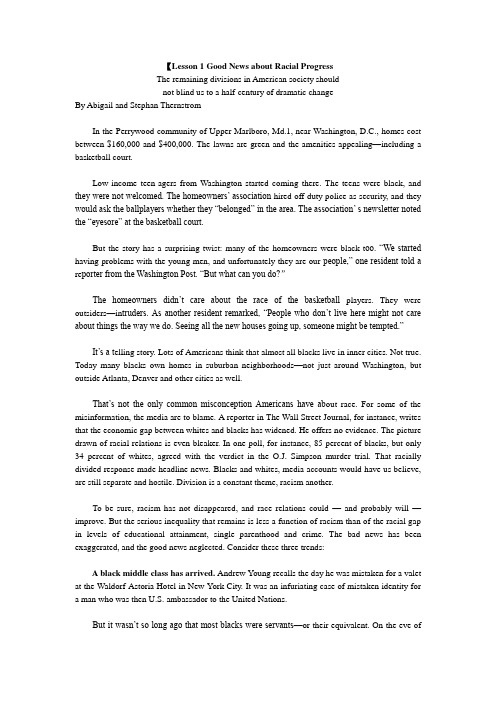
【Lesson 1 Good News about Racial ProgressThe remaining divisions in American society shouldnot blind us to a half-century of dramatic changeBy Abigail and Stephan ThernstromIn the Perrywood community of Upper Marlboro, Md.1, near Washington, D.C., homes cost between $160,000 and $400,000. The lawns are green and the amenities appealing—including a basketball court.Low-income teen-agers from Washington started coming there. The teens were black, and they were not welcomed. The homeowners’ association hired off-duty police as security, and they would ask the ballplayers whether they “belonged” in the area. The association’ s newsletter noted the “eyesore” at the basketball court.But the story has a surprising twist: many of the homeowners were black t oo. “We started having problems with the young men, and unfortunately they are our people,” one resident told a re porter from the Washington Post. “But what can you do?”The homeowners didn’t care about the race of the basketball players. They were outsiders—in truders. As another resident remarked, “People who don’t live here might not care about things the way we do. Seeing all the new houses going up, someone might be tempted.”It’s a t elling story. Lots of Americans think that almost all blacks live in inner cities. Not true. Today many blacks own homes in suburban neighborhoods—not just around Washington, but outside Atlanta, Denver and other cities as well.That’s not the only common misconception Americans have ab out race. For some of the misinformation, the media are to blame. A reporter in The Wall Street Journal, for instance, writes that the economic gap between whites and blacks has widened. He offers no evidence. The picture drawn of racial relations is even bleaker. In one poll, for instance, 85 percent of blacks, but only 34 percent of whites, agreed with the verdict in the O.J. Simpson murder trial. That racially divided response made headline news. Blacks and whites, media accounts would have us believe, are still separate and hostile. Division is a constant theme, racism another.To be sure, racism has not disappeared, and race relations could —and probably will —improve. But the serious inequality that remains is less a function of racism than of the racial gap in levels of educational attainment, single parenthood and crime. The bad news has been exaggerated, and the good news neglected. Consider these three trends:A black middle class has arrived. Andrew Young recalls the day he was mistaken for a valet at the Waldorf-Astoria Hotel in New York City. It was an infuriating case of mistaken identity for a man who was then U.S. ambassador to the United Nations.But it wasn’t so long ago that most blacks were servants—or their equivalent. On the eve ofWorld War II, a trivial five percent of black men were engaged in white-collar work of any kind, and six out of ten African-American women were employed as domestics.In 1940 there were only 1,000 practicing African-American lawyers; by 1995 there were over 32,000, about four percent of all attorneys.Today almost three-quarters of African-American families have incomes above the government poverty line. Many are in the middle class, according to one useful index—earning double the government poverty level; in 1995 this was $30,910 for a two-parent family with two children and $40,728 for a two-parent family with four children. Only one black family in 100 enjoyed a middle-class income in 1940; by 1995 it was 49 in 100. And more than 40 percent of black households also own their homes. That’ s a huge change.The typical white family still earns a lot more than the black family because it is more likely to collect two paychecks. But if we look only at married couples—much of the middle class—the white-black income gap shrinks to 13 percent. Much of that gap can be explained by the smaller percentage of blacks with college degrees, which boost wages, and the greater concentration of blacks in the South, where wages tend to be lower.Blacks are moving to the suburbs. Following the urban riots of the mid-1960s, the presidential Kerner Commission14 concluded that the nation’ s future was menaced by “accelerating segregation”—black central cities and whites outside the core. That segregation might well blow the country apart, it said.It’ s true that whites have continued to leave inner cities for the suburbs, but so, too, have blacks. The number of black suburban dwellers in the last generation has almost tripled to 10.6 million. In 1970 metropolitan Atlanta, for example, 27 percent of blacks lived in the suburbs with 85 percent of whites. By 1990, 64 percent of blacks and 94 percent of whites resided there.This is not phony integration, with blacks moving from one all-black neighborhood into another. Most of the movement has brought African-Americans into neighborhoods much less black15 than those they left behind, thus increasing integration. By 1994 six in ten whites reported that they lived in neighborhoods with blacks.Residential patterns do remain closely connected to race. However, neighborhoods have become more racially mixed, and residential segregation has been decreasing.Bigotry has declined. Before World Was ft, Gunnar Myrdal16 roamed the South researching An American Dilemma, the now-classic book that documented17 the chasm betwe en the nation’s ideals and its racial practices, hi one small Southern city, he kept asking whites how he could find “Mr. Jim Smith,” an African-American who was principal of a black high school. No one seemed to know who he was. After he finally found Smith, Myrdal was told that he should have just asked for “Jim.” That’ s how great was white aversion to dignifying African-Americans with “Mr.” Or “Mrs.”Bigotry was not just a Southern problem. A national survey in the 1940s asked whether “Ne-groes shoul d have as good a chance as white people to get any kind of job.” A majority of whites said that “white people should have the first chance at any kind of job.”19. Such a question would not even be asked today. Except for a lunatic fringe18, no whites would sign on to such a notion.1920. In 1964 less than one in five whites reported having a black friend. By 1989 more than two out of three did. And more than eight often African -Americans had a white friend.21. What about the last taboo?20 In 1963 ten percent of whites approved of black-white dating; by 1994 it was 65 percent. Interracial marriages? Four percent of whites said it was okay in 1958; by 1994 the figure had climbed more than elevenfold, to 45 percent. These surveys measure opinion, but behavior has also changed. In 1963 less than one percent of marriages by African- Americans were racially mixed. By 1993, 12 percent were.22. Today black Americans can climb the ladder to the top.21 Ann M. Fudge is already there; she’s in charge of manufacturing, promotion and sales at the $2.7-billion Maxwell House Coffee and Post Cereals divisions of Kraft Foods.22 So are Kenneth Chenault, president and chief operating officer at American Express23 and Richard D. Parsons, president of Time Warner, Inc.24 After the 1988 Demo-cratic Convention25, the Rev. Jesse Jackson26 talked about his chances of making it to the White House. “I may not get there,” he said “But it is possible for our children to get there now.”23. Even that seems too pessimistic. Consider how things have improved since Colin and Alma Powell27 packed their belongings into a V olkswagen28 and left Fort Devens, Mass., for Fort Bragg, N. C. “I remember passing Woodbridgc, Va.,” General Powell wrote in his autobiogra phy, “and not finding even a gas-station bathroom that we were allowed to use.” That was in 1962. In 1996 reliable polls suggest he could have been elected President.24. Progress over the last half-century has been dramatic. As Corctta Scott King wrote not long ago, the ideals for which her husband Martin Luther King Jr. died, have become “deeply embedded in the very fabric of America29.”From Reader’s Digest, March, 1998V. Analysis of Content1. According to the author, ___________A. racism has disappeared in AmericaB. little progress has been made in race relationsC. media reports have exaggerated the racial gapD. media accounts have made people believe that the gap between blacks and whites has become narrower2. What the Kerner Commi ssion meant by “accelerating segregation” was that __________A. more and more whites and blacks were forced to live and work separatelyB. more and more blacks lived in the central cities, and whites outside the coreC. more and more whites lived in the central cities, and blacks outside the coreD. nowadays more and more blacks begin to live in the suburbs3. The last taboo in the article is about ____________.A. political status of America’s minority peopleB. economic status of America’ s minori ty peopleC. racial integrationD. interracial marriages4. Gunnar Myrdal kept asking whites how he could find “Mr. Jim Smith,” but no one seemed to know who he was, because _____________.A. there was not such a person called Jim SmithB. Jim Smith was not famousC. the whites didn ‘t know Jim SmithD. the white people considered that a black man did not deserve the title of “Mr.”5. In the author’s opinion, _A. few black Americans can climb the ladder to the topB. Jesse Jackson’ s words in th is article seemed too pessimisticC. Colin Powell could never have been elected PresidentD. blacks can never become America’ s PresidentVI. Questions on the Article1. Why were those low-income teen-agers who came to the Perrywood community consid-ered to be “the eyesore”?2. What is the surprising twist of the story?3. According to this article, what has caused much of the white-black income gap?4. Why did the presidential Kerner Commission conclude that the nation’ s future was menaced by “accelerating segregation”?5. Why wouldn’t questions as “Should negroes have as good a chance as white people to get any kind of job?” be asked today?Topics for Discussion1. Can you tell briefly the dramatic progress in the status of America’ s minority p eople over the last half-century?2. Do you think the article is unbiased? What do you think of the author s view on the African-Americans?1. amenity: n. A. The quality of being pleasant or attractive; agreeableness. 怡人:使人愉快或吸引人的性质;使人愉快 B. A feature that increases attractiveness or value, especially of a piece of real estate or a geographic location.生活福利设施;便利设施:能够增加吸引力或价值的事物,特别是不动产或地理位置⊙ We enjoy all the -ties of home life. 我们享受家庭生活的一切乐趣。
最新英美报刊选读—Unit 1

最新英美报刊选读_Unit 1 serving Languages Is About More Than Words
Language Features Background Information WarmingWarming-up Questions Organization Analysis Detailed Reading PostPost-Reading
最新英美报刊选读_Unit 1 Focus
WarmingWarming-up Questions
What can we do to preserve dying language?
• Already, after only a few weeks of work, the students are well on their way to reaching their first-year goal to create a dictionary with 1,500 entries and a lesson plan to be used throughout the year. • They have also begun teaching classes to many of the community’s children and adults. Beier said that an average of 20 adults and 35 youth, ranging in age from 6 to 16, attend their classes—a significant portion of San Antonio’s total population of about 400 people.
最新英美报刊选读_Unit 1 Focus
英语报刊选读unit1Politics资料

Inauguration ceremony, 2013
The Inauguration
1月20日,在华盛顿,大批观众观看奥巴马就职典礼。
Text study
The Higher Education of Washington
Universities step up lobbying to protect funding interests.
Key Words:
Liberal, Left-wing, Progressive, social
Recent Democratic Presidents:
Barack Obama William J. Clinton
Electing President
1. Primary election (Feb.-June)
The US political system is often referred to as a “two-party system”
While in reality there are many different parties, there are only two which hold the vast majority of power and influence, as well as most of the elected offices in the country.
NOT POPULAR VOTE BUT ELECTORAL VOTES
2. The major parties hold conventions
to choose candidates for President to determine the parties platforms
英语报刊阅读Lesson One Text
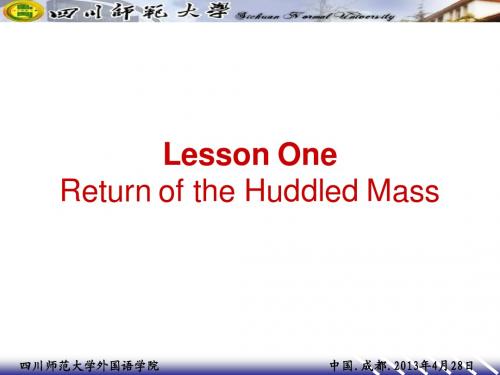
四川师范大学外国语学院
中国.成都.2010年 中国.成都.2010年9月2日
Background
Before the first world war came the next immigrants. In 1917 the law was established, that everyone must read and write to came in the US. Then the Great Depression came and after this the second world war broke out, not so many immigrants came. A new law ,which includes that not more than 150000 immigrants per year can come. After the Second World war they arrived in large numbers from Mexico and Latin America. Many of them were illegal once.
四川师范大学外国语学院 中国.成都.2010年 中国.成都.2010年9月2日
IV. Focuses of controversy concerning present immigrants(10--13) a. On the number b. On the origin c. On the issues of optimum(最有利的 最有利的) 最有利的 population size, new comers’ commitment to America and its values d. On the job skills V. Author’ s view (14) Байду номын сангаас. Adjusting immigration policy by laying greater emphasis on job skill b. Immigrants’ sole desire--to be part of the American Dream
美英报刊阅读lesson

live with a bit more chaos and more easily adopt a big picture view. If my wife and I
sw“atothpmisp”aehkdereapnroeosfeviterisoratnolls“s,suhlmiefemcaewrdyoe, usmtlodmmcsyetesrttnyadleintolyfdebael more orderly. But she cedes to my style of papmreaornesttnliyntinigngd”beientacthilaseuapsnredvkIioeauemspsoeirnndtecrnshc.ae.rge of the day-tHoe-dr abyislituyfft.oHdeor athbisility to do this is a key
PART THREE
READING COMPREHENSION
PART THREE READING COMPREHENSION Tiger Mom... Meet Panda Dad
By Alan Paul
PART THREE
Tiger Mom... Meet Panda Dad
I have watched the 1uproar over theTigTiegreMr Momom debate with growing annoyance that one simple question remains unasked: Where are the dads?
PART THREE
Call me the Panda Dad; I am happy to parent with cuddliness, but not afraid to
英美报刊阅读第一课译文(第三版)

Home at last这是其中的一个通宵gabfests学生在毕业时,他们将友情,裸露最深的感觉。
只有这是更严重的:11同学聚集在公寓在哈佛商学院校园1999年5月,是中国的命运抗争。
包围着空啤酒瓶和包薯片,朋友们——所有来自中国大陆——正在讨论是否要回家了。
他们每个人都已经收到了来自美国顶尖的公司。
当然,中国发生了巨大变化的十年以来,他们中的大多数人都离开了。
政治和抗议仍是禁忌,但美国现在提供了更多的个人自由和经济的机会比以往任何时候都多。
和它急需精英经理喜欢他们。
张伟,一个活跃的29岁女性的梦想是成为中国的美国脱口秀主持人奥普拉·温芙瑞,恳求她的同学凭著他们回家。
“我们不会牺牲现在为了明天,”她说。
“我们应该马上做我们真正想做的事。
”这个词是纯粹的金钱,但他们证明预言。
在几周的时间里,也不愿在这房间里的最年轻的人——一个26岁的前国家数学冠军名叫哨Yibo——那里商业建议、出售他的财产留给了上海,他在那里举行中国版的网上拍卖巨人易趣。
在路上,他停下来休息一天在硅谷和说服投资者给他40万美元。
几周之后,同学镡海鹰回到上海拜访朋友开始之前一个银行的工作在纽约。
她从不使用她的回程机票到美国:邵说服她去参加他的公司的首席运营官。
三其他成员在一年之内的小团体——欢一茗,妮陈和赫伯特王建民——也回发射启动公司。
和张吗?她的工作是business-development降落在鲁珀特·默多克新闻集团在北京。
她也加班追求金钱的梦想。
一旦一个星期她主持一个受欢迎的电视脱口秀节目,在北京的主题是如此大胆艾滋病、药物滥用和——是的——网上约会。
长时间的中国学生聚集在HBS的,他们并不是寻找一个逃跑,但是他们最终的边缘。
经过多年的咨询公司,跨国公司或创业,所有的人都觉得需要更进一步的了解西方商业文化。
哈佛,中国学生迅速移聚在一起。
旧的手帮助新来的人学会开车,买菜,乘坐地铁。
三个人一起住在一所公寓里,因为他们煮中国菜,事情很快就成了。
英美报刊选读unit 1

参
考
资
料
1.新编英语报刊导读
2.英语报刊阅读教程
延边大学教案
第1周,第1次课
章节
名称
Unit One Introduction to English News
授课
方式
全日制教学
教 学
时 数
2学时
教学
目的
要求
1.To learn about the basic concepts in Englishjournalism.
Blurring demarcation line:
Is a story about the private life of a politician "politics" or "entertainment"?
Is an article about“Tycoon buys looted treasure for nation”a "business" story or a "cultural legacy" story? Judging solely on subject matter, it can be difficult to tell
(4)Newspapers and magazines.
(5)An academic course training students in journalism.
(6)Written material of current interest or wide popular appeal.
2.The mass media today
In terms of style:
第3版美英报刊阅读教程(端木版)目录
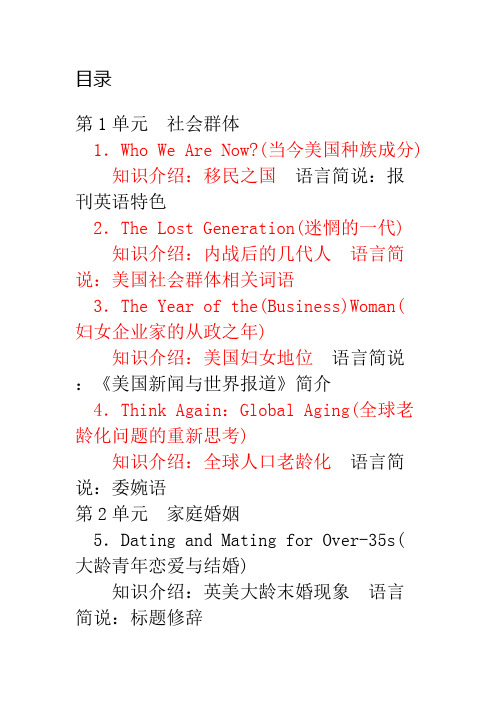
目录第1单元社会群体1.Who We Are Now?(当今美国种族成分)知识介绍:移民之国语言简说:报刊英语特色2.The Lost Generation(迷惘的一代)知识介绍:内战后的几代人语言简说:美国社会群体相关词语3.The Year of the(Business)Woman(妇女企业家的从政之年)知识介绍:美国妇女地位语言简说:《美国新闻与世界报道》简介4.Think Again:Global Aging(全球老龄化问题的重新思考)知识介绍:全球人口老龄化语言简说:委婉语第2单元家庭婚姻5.Dating and Mating for Over-35s(大龄青年恋爱与结婚)知识介绍:英美大龄末婚现象语言简说:标题修辞6.Working at Home: Family-friendly?(在家办公是否有益家庭生活?)知识介绍:家庭与工作关系语言简说:标题常用符号7.The Future of Abortion(堕胎问题的发展前景)知识介绍:美国妇女堕胎问题语言简说:《新闻周刊》介绍8.The War over “Family Values”(家庭价值观的论战)知识介绍:美国单亲家庭语言简说:报刊用喻第3单元文教娱乐9.Me Me Media(个性化的媒体)知识介绍:Web 2.0:一场新的网络变革语言简说:《读者文摘》简介10.Reining in the Test of Tests(严控高考题型)知识介绍:高校招生语言简说:新闻标题的结构11.Plot Claange:Foreign Forces Tr aforin HollywoodFilms(改变好莱坞电影的外国因素)知识介绍:美国电影全球化策略语言简说:词语+er构词12.Get Moving!(动起来!)知识介绍:健康与锻炼语言简说:《时代》周刊介绍第4单元衣食住行13.The Decline of Neatness(行为标准的蜕化)知识介绍:美国人的穿着语言简说:闲适性评论语言特色14.The Deadly Noodle(~命的饮食)知识介绍:饮食与肥胖语言简说:词语文化内涵15.Thrown Together in a Crisis,Strange Share Ca and LifeStories(危难时拼车相聚,陌生人亲切交谈)知识介绍:纽约公交罢工语言简说:《纽约时报》简介16.“Exurbs”Floudsh,but Is This Really What WeWant?(城市远郊扩张,是否符合愿望?) 【2版1单元L4】知识介绍:城市无序扩张语言简说:拼缀词第5单元观念风尚17.How Anglo Is America(美国特性中有多少英国文化成分)知识介绍:英国文化对美国文化影响深远语言简说:派生构词18.Economic Downturn Has More Folks Stashing TheirCash(经济衰退促使更多人存款)知识介绍:美国人消费观的变化语言简说《今日美国报》简介19.Do the Elderly Want to Work?(老年人想干工作吗?)知识介绍:美国退休问题语言简说:报刊常用俚语20.Regular Folks Get the Star Treatment(普通人享受日月星待遇)知识介绍:美国人爱美容语言简说:特写常用导语第6单元政治体制21.Who's Sorry Now?(是谁在难受?)知识介绍:游说活动语言简说:词性转化22.What Deep Throat did(“深喉”到底做了什么?)知识介绍:水门事件语言简说:新闻报道引语23.The Neocon Revolution(新保守主义革命)知识介绍:新保守主义语言简说:报刊翻译常见错误24.Ever Higher Society,Ever Harde r to Ascend(社会阶梯越来越高,地位攀升越来越难)知识介绍:美国阶级状况语言简说:词义变化第7单元企业经济25.E-Biz Strikes Again!(电子商务再次袭击)知识介绍:电子商务语言简说:网络新词常用词缀26.Why the Dollar's Reign Is Near an End(美元统治地位缘何即将结束)知识介绍:美元地位语言简说:习语活用27.The Grapes of wrath,Again(“愤怒的葡萄”情景再现)知识介绍:美国非法移民语言简说:报刊常用典故28.The Changing Face of American Jobs(美国就业市场的变化)知识介绍:美国劳力市场结构变化语言简说:复合词第8单元科技军事29.GPS NaVigation Moves to Your Pa lm(全球定位系统装置进入手中)知识介绍:GPS的前世今生语言简说:名词定语30.Medicine's Wild Kingdom(生物医学的王国)知识介绍:生物制药语言简说:前置定语31.Power Revolution(能源革命)知识介绍:再生能源语言简说:缩略词32.Cadets Trade the Trenches for F irewalls(军校学员的网络战演习)知识介绍:网络战语言简说:标题短词第9单元社会问题33.The Other America(美国的另外一面)知识介绍:卡特里娜飓风语言简说:嵌入结构34.In Congress,the Uphill Battle for Gun Control(国会限枪之战难以取胜)知识介绍:枪支问题语言简说:外刊与文化35.Should Drugs Be Legalized?(毒品应该合法化吗?)知识介绍:美国吸毒问题语言简说:称号、职务前置36.Homeless U.S.A(美国的无家可归问题)知识介绍:美国住房情况语言简说:解释性报道第10单元世界风云37.Three Lessons from London(伦敦爆炸案的教训)知识介绍:恐怖主义语言简说:借代38.After the Flames(骚乱平息后的反思)知识介绍:移民问题语言简说:“说”意动词39.The Weakest Link(世界最弱的环节)知识介绍:伊拉克战争语言简说:外报外刊中意识形态的表现40.Fight for the T0p of the World(北极之争)知识介绍:北极之争语言简说:版面与图片。
- 1、下载文档前请自行甄别文档内容的完整性,平台不提供额外的编辑、内容补充、找答案等附加服务。
- 2、"仅部分预览"的文档,不可在线预览部分如存在完整性等问题,可反馈申请退款(可完整预览的文档不适用该条件!)。
- 3、如文档侵犯您的权益,请联系客服反馈,我们会尽快为您处理(人工客服工作时间:9:00-18:30)。
【Lesson 1 Good News about Racial ProgressThe remaining divisions in American society shouldnot blind us to a half-century of dramatic changeBy Abigail and Stephan ThernstromIn the Perrywood community of Upper Marlboro, Md.1, near Washington, D.C., homes cost between $160,000 and $400,000. The lawns are green and the amenities appealing—including a basketball court.Low-income teen-agers from Washington started coming there. The teens were black, and they were not welcomed. The homeowners’ association hired off-duty police as security, and they would ask the ballplayers whether they “belonged” in the area. The association’ s newsletter noted the “eyesore” at the basketball court.But the story has a surprising twist: many of the homeowners were black t oo. “We started having problems with the young men, and unfortunately they are our people,” one resident told a re porter from the Washington Post. “But what can you do?”The homeowners didn’t care about the race of the basketball players. They were outsiders—in truders. As another resident remarked, “People who don’t live here might not care about things the way we do. Seeing all the new houses going up, someone might be tempted.”It’s a t elling story. Lots of Americans think that almost all blacks live in inner cities. Not true. Today many blacks own homes in suburban neighborhoods—not just around Washington, but outside Atlanta, Denver and other cities as well.That’s not the only common misconception Americans have ab out race. For some of the misinformation, the media are to blame. A reporter in The Wall Street Journal, for instance, writes that the economic gap between whites and blacks has widened. He offers no evidence. The picture drawn of racial relations is even bleaker. In one poll, for instance, 85 percent of blacks, but only 34 percent of whites, agreed with the verdict in the O.J. Simpson murder trial. That racially divided response made headline news. Blacks and whites, media accounts would have us believe, are still separate and hostile. Division is a constant theme, racism another.To be sure, racism has not disappeared, and race relations could —and probably will —improve. But the serious inequality that remains is less a function of racism than of the racial gap in levels of educational attainment, single parenthood and crime. The bad news has been exaggerated, and the good news neglected. Consider these three trends:A black middle class has arrived. Andrew Young recalls the day he was mistaken for a valet at the Waldorf-Astoria Hotel in New York City. It was an infuriating case of mistaken identity for a man who was then U.S. ambassador to the United Nations.But it wasn’t so long ago that most blacks were servants—or their equivalent. On the eve ofWorld War II, a trivial five percent of black men were engaged in white-collar work of any kind, and six out of ten African-American women were employed as domestics.In 1940 there were only 1,000 practicing African-American lawyers; by 1995 there were over 32,000, about four percent of all attorneys.Today almost three-quarters of African-American families have incomes above the government poverty line. Many are in the middle class, according to one useful index—earning double the government poverty level; in 1995 this was $30,910 for a two-parent family with two children and $40,728 for a two-parent family with four children. Only one black family in 100 enjoyed a middle-class income in 1940; by 1995 it was 49 in 100. And more than 40 percent of black households also own their homes. That’ s a huge change.The typical white family still earns a lot more than the black family because it is more likely to collect two paychecks. But if we look only at married couples—much of the middle class—the white-black income gap shrinks to 13 percent. Much of that gap can be explained by the smaller percentage of blacks with college degrees, which boost wages, and the greater concentration of blacks in the South, where wages tend to be lower.Blacks are moving to the suburbs. Following the urban riots of the mid-1960s, the presidential Kerner Commission14 concluded that the nation’ s future was menaced by “accelerating segregation”—black central cities and whites outside the core. That segregation might well blow the country apart, it said.It’ s true that whites have continued to leave inner cities for the suburbs, but so, too, have blacks. The number of black suburban dwellers in the last generation has almost tripled to 10.6 million. In 1970 metropolitan Atlanta, for example, 27 percent of blacks lived in the suburbs with 85 percent of whites. By 1990, 64 percent of blacks and 94 percent of whites resided there.This is not phony integration, with blacks moving from one all-black neighborhood into another. Most of the movement has brought African-Americans into neighborhoods much less black15 than those they left behind, thus increasing integration. By 1994 six in ten whites reported that they lived in neighborhoods with blacks.Residential patterns do remain closely connected to race. However, neighborhoods have become more racially mixed, and residential segregation has been decreasing.Bigotry has declined. Before World Was ft, Gunnar Myrdal16 roamed the South researching An American Dilemma, the now-classic book that documented17 the chasm betwe en the nation’s ideals and its racial practices, hi one small Southern city, he kept asking whites how he could find “Mr. Jim Smith,” an African-American who was principal of a black high school. No one seemed to know who he was. After he finally found Smith, Myrdal was told that he should have just asked for “Jim.” That’ s how great was white aversion to dignifying African-Americans with “Mr.” Or “Mrs.”Bigotry was not just a Southern problem. A national survey in the 1940s asked whether “Ne-groes shoul d have as good a chance as white people to get any kind of job.” A majority of whites said that “white people should have the first chance at any kind of job.”19. Such a question would not even be asked today. Except for a lunatic fringe18, no whites would sign on to such a notion.1920. In 1964 less than one in five whites reported having a black friend. By 1989 more than two out of three did. And more than eight often African -Americans had a white friend.21. What about the last taboo?20 In 1963 ten percent of whites approved of black-white dating; by 1994 it was 65 percent. Interracial marriages? Four percent of whites said it was okay in 1958; by 1994 the figure had climbed more than elevenfold, to 45 percent. These surveys measure opinion, but behavior has also changed. In 1963 less than one percent of marriages by African- Americans were racially mixed. By 1993, 12 percent were.22. Today black Americans can climb the ladder to the top.21 Ann M. Fudge is already there; she’s in charge of manufacturing, promotion and sales at the $2.7-billion Maxwell House Coffee and Post Cereals divisions of Kraft Foods.22 So are Kenneth Chenault, president and chief operating officer at American Express23 and Richard D. Parsons, president of Time Warner, Inc.24 After the 1988 Demo-cratic Convention25, the Rev. Jesse Jackson26 talked about his chances of making it to the White House. “I may not get there,” he said “But it is possible for our children to get there now.”23. Even that seems too pessimistic. Consider how things have improved since Colin and Alma Powell27 packed their belongings into a V olkswagen28 and left Fort Devens, Mass., for Fort Bragg, N. C. “I remember passing Woodbridgc, Va.,” General Powell wrote in his autobiogra phy, “and not finding even a gas-station bathroom that we were allowed to use.” That was in 1962. In 1996 reliable polls suggest he could have been elected President.24. Progress over the last half-century has been dramatic. As Corctta Scott King wrote not long ago, the ideals for which her husband Martin Luther King Jr. died, have become “deeply embedded in the very fabric of America29.”From Reader’s Digest, March, 1998V. Analysis of Content1. According to the author, ___________A. racism has disappeared in AmericaB. little progress has been made in race relationsC. media reports have exaggerated the racial gapD. media accounts have made people believe that the gap between blacks and whites has become narrower2. What the Kerner Commi ssion meant by “accelerating segregation” was that __________A. more and more whites and blacks were forced to live and work separatelyB. more and more blacks lived in the central cities, and whites outside the coreC. more and more whites lived in the central cities, and blacks outside the coreD. nowadays more and more blacks begin to live in the suburbs3. The last taboo in the article is about ____________.A. political status of America’s minority peopleB. economic status of America’ s minori ty peopleC. racial integrationD. interracial marriages4. Gunnar Myrdal kept asking whites how he could find “Mr. Jim Smith,” but no one seemed to know who he was, because _____________.A. there was not such a person called Jim SmithB. Jim Smith was not famousC. the whites didn ‘t know Jim SmithD. the white people considered that a black man did not deserve the title of “Mr.”5. In the author’s opinion, _A. few black Americans can climb the ladder to the topB. Jesse Jackson’ s words in th is article seemed too pessimisticC. Colin Powell could never have been elected PresidentD. blacks can never become America’ s PresidentVI. Questions on the Article1. Why were those low-income teen-agers who came to the Perrywood community consid-ered to be “the eyesore”?2. What is the surprising twist of the story?3. According to this article, what has caused much of the white-black income gap?4. Why did the presidential Kerner Commission conclude that the nation’ s future was menaced by “accelerating segregation”?5. Why wouldn’t questions as “Should negroes have as good a chance as white people to get any kind of job?” be asked today?Topics for Discussion1. Can you tell briefly the dramatic progress in the status of America’ s minority p eople over the last half-century?2. Do you think the article is unbiased? What do you think of the author s view on the African-Americans?1. amenity: n. A. The quality of being pleasant or attractive; agreeableness. 怡人:使人愉快或吸引人的性质;使人愉快 B. A feature that increases attractiveness or value, especially of a piece of real estate or a geographic location.生活福利设施;便利设施:能够增加吸引力或价值的事物,特别是不动产或地理位置⊙ We enjoy all the -ties of home life. 我们享受家庭生活的一切乐趣。
